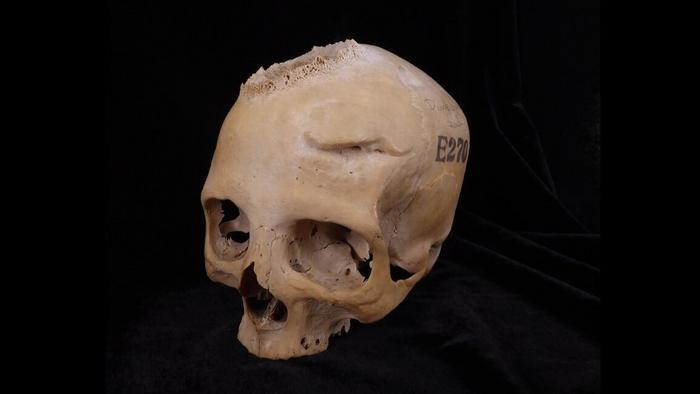4,000-year-old skull provides evidence of early attempts at brain surgery to treat cancer
We see that although ancient Egyptians were able to deal with complex cranial fractures, cancer was still a medical knowledge frontier

Ancient Egyptians were exceptionally skilled in medicine for their time. They could identify, describe, and treat a variety of diseases and traumatic injuries, build prosthetics, and even put in dental fillings. However, some conditions, like cancer, remained beyond their treatment capabilities.
An international team of researchers recently explored the limits of ancient Egyptian traumatological and oncological treatments by studying two human skulls, each thousands of years old.
"We see that although ancient Egyptians were able to deal with complex cranial fractures, cancer was still a medical knowledge frontier," said Tatiana Tondini, a researcher at the University of Tübingen and first author of the study published in Frontiers in Medicine.
Prof. Edgard Camarós, a paleopathologist at the University of Santiago de Compostela and lead author of the study, added, "This finding is unique evidence of how ancient Egyptian medicine would have tried to deal with or explore cancer more than 4,000 years ago. This is an extraordinary new perspective in our understanding of the history of medicine."
Cutting Away Cancer
The researchers aimed to understand the role of cancer in ancient societies, its prevalence in antiquity, and how those societies interacted with this disease. To do this, they examined two skulls from the University of Cambridge’s Duckworth Collection.
Skull and mandible 236, dating from between 2687 and 2345 BCE, belonged to a male individual aged 30 to 35. Skull E270, dating from between 663 and 343 BCE, belonged to a female individual who was over 50 years old.
Related Stories
On skull 236, microscopic observation revealed a large lesion consistent with excessive tissue destruction, known as neoplasm. Additionally, there were about 30 small, round metastasized lesions scattered across the skull.
The discovery of cut marks around these lesions, likely made with a sharp object such as a metal instrument, stunned the researchers.
“When we first observed the cut marks under the microscope, we could not believe what was in front of us,” said Tondini. Co-author Prof.
Albert Isidro, a surgical oncologist at the University Hospital Sagrat Cor and an Egyptology specialist, explained, "It seems ancient Egyptians performed some kind of surgical intervention related to the presence of cancerous cells, proving that ancient Egyptian medicine was also conducting experimental treatments or medical explorations in relation to cancer."
Skull E270 also showed a large lesion consistent with a cancerous tumor that led to bone destruction. This finding indicates that, despite today's lifestyle factors and cancer-causing substances increasing cancer risk, cancer was also a common pathology in the past.
Additionally, skull E270 had two healed lesions from traumatic injuries. One of these injuries seemed to have originated from a close-range violent event using a sharp weapon. The healed nature of these lesions suggests the individual potentially received some form of treatment and survived.
The presence of such a wound on a female individual is uncommon, as most violence-related injuries are found on males. “Was this female individual involved in any kind of warfare activities?” Tondini asked. “If so, we must rethink the role of women in the past and how they took active part in conflicts during antiquity.”
However, the researchers also acknowledged the challenges of studying skeletal remains. These remains are often incomplete, and there is no known clinical history, making definitive statements difficult. "In archaeology, we work with a fragmented portion of the past, complicating an accurate approach," Isidro pointed out.
Future Research Directions
“This study contributes to a changing of perspective and sets an encouraging base for future research on the field of paleo-oncology, but more studies will be needed to untangle how ancient societies dealt with cancer,” concluded Camarós.
By examining these ancient remains, researchers are not only uncovering the medical practices of the past but also gaining insights into the social roles and daily lives of ancient peoples. The findings from these skulls highlight the advanced nature of ancient Egyptian medicine and its exploratory approach to diseases like cancer, shedding light on how these early societies might have confronted some of the same health challenges we face today.
This research underscores the complexity and sophistication of ancient Egyptian medical practices and opens up new avenues for understanding the history of medicine. It suggests that while ancient Egyptians were pioneering in many areas of healthcare, they were also confronting the limitations and unknowns of their time, much like modern medicine continues to do today.
For more science and technology stories check out our New Discoveries section at The Brighter Side of News.
Note: Materials provided above by The Brighter Side of News. Content may be edited for style and length.
Like these kind of feel good stories? Get the Brighter Side of News' newsletter.
Joshua Shavit
Science & Technology Writer | AI and Robotics Reporter
Joshua Shavit is a Los Angeles-based science and technology writer with a passion for exploring the breakthroughs shaping the future. As a contributor to The Brighter Side of News, he focuses on positive and transformative advancements in AI, technology, physics, engineering, robotics and space science. Joshua is currently working towards a Bachelor of Science in Business Administration at the University of California, Berkeley. He combines his academic background with a talent for storytelling, making complex scientific discoveries engaging and accessible. His work highlights the innovators behind the ideas, bringing readers closer to the people driving progress.



